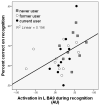Crack cocaine use impairs anterior cingulate and prefrontal cortex function in women with HIV infection
- PMID: 24760360
- PMCID: PMC4090256
- DOI: 10.1007/s13365-014-0250-x
Crack cocaine use impairs anterior cingulate and prefrontal cortex function in women with HIV infection
Abstract
Crack cocaine use is associated with impaired verbal memory in HIV-infected women more than uninfected women. To understand the neural basis for this impairment, this study examined the effects of crack cocaine use on activation of the prefrontal cortex (PFC) and strategic encoding during a verbal memory task in HIV-infected women. Three groups of HIV-infected women from the Chicago Consortium of the Women's Interagency HIV Study were compared: current users of crack cocaine (n = 10), former users of cocaine (n = 11), and women who had never used cocaine (n = 9). Participants underwent functional magnetic resonance imaging during a verbal memory task and completed a neuropsychological test of verbal memory. On the neuropsychological test, current crack users performed significantly worse than other groups on semantic clustering, a measure of strategic encoding, p < 0.05. During encoding, activation in left anterior cingulate cortex (ACC) was lower in current and former cocaine users compared to never users. During recognition, activation in bilateral PFC, specifically left dorsal medial PFC and bilateral dorsolateral PFC, was lower in current and former users compared to women who had never used cocaine. Lower activation in left dorsolateral PFC was correlated with worse performance on the recognition task, p < 0.05. The verbal learning and memory deficits associated with cocaine use in women with HIV may be partially accounted for by alterations in ACC and PFC function.
Conflict of interest statement
The authors declare that they have no conflict of interest.
All authors declare that they have no conflict of interest: Vanessa Meyer, Deborah Little, Daniel Fitzgerald, Erin Sundermann, Leah Rubin, Eileen Martin, Kathleen Weber, Mardge Cohen, and Pauline Maki.
Figures





Similar articles
-
Prefrontal cortical volume loss is associated with stress-related deficits in verbal learning and memory in HIV-infected women.Neurobiol Dis. 2016 Aug;92(Pt B):166-74. doi: 10.1016/j.nbd.2015.09.010. Epub 2015 Sep 25. Neurobiol Dis. 2016. PMID: 26408051 Free PMC article.
-
Elevated stress is associated with prefrontal cortex dysfunction during a verbal memory task in women with HIV.J Neurovirol. 2016 Dec;22(6):840-851. doi: 10.1007/s13365-016-0446-3. Epub 2016 Apr 19. J Neurovirol. 2016. PMID: 27094924 Free PMC article.
-
Cognitive related electrophysiological changes induced by non-invasive cortical electrical stimulation in crack-cocaine addiction.Int J Neuropsychopharmacol. 2014 Sep;17(9):1465-75. doi: 10.1017/S1461145714000522. Epub 2014 Apr 28. Int J Neuropsychopharmacol. 2014. PMID: 24776374
-
The neuropsychiatry of chronic cocaine abuse.J Neuropsychiatry Clin Neurosci. 1998 Summer;10(3):280-9. doi: 10.1176/jnp.10.3.280. J Neuropsychiatry Clin Neurosci. 1998. PMID: 9706535 Review.
-
Associations between use of crack cocaine and HIV-1 disease progression: research findings and implications for mother-to-infant transmission.Life Sci. 2011 May 23;88(21-22):931-9. doi: 10.1016/j.lfs.2011.01.003. Epub 2011 Jan 8. Life Sci. 2011. PMID: 21219914 Free PMC article. Review.
Cited by
-
Cortical consequences of HIV-1 Tat exposure in rats are enhanced by chronic cocaine.Curr HIV Res. 2015;13(1):80-7. doi: 10.2174/0929867322666150311164504. Curr HIV Res. 2015. PMID: 25760043 Free PMC article. Review.
-
Lack of Effects of Extended Sessions of Transcranial Direct Current Stimulation (tDCS) Over Dorsolateral Prefrontal Cortex on Craving and Relapses in Crack-Cocaine Users.Front Pharmacol. 2018 Oct 23;9:1198. doi: 10.3389/fphar.2018.01198. eCollection 2018. Front Pharmacol. 2018. PMID: 30405414 Free PMC article.
-
Prefrontal cortical volume loss is associated with stress-related deficits in verbal learning and memory in HIV-infected women.Neurobiol Dis. 2016 Aug;92(Pt B):166-74. doi: 10.1016/j.nbd.2015.09.010. Epub 2015 Sep 25. Neurobiol Dis. 2016. PMID: 26408051 Free PMC article.
-
HIV, Tat and dopamine transmission.Neurobiol Dis. 2017 Sep;105:51-73. doi: 10.1016/j.nbd.2017.04.015. Epub 2017 Apr 27. Neurobiol Dis. 2017. PMID: 28457951 Free PMC article. Review.
-
Chemogenetic Activation of Medial Prefrontal Cortex Projections to the Nucleus Accumbens Shell Suppresses Cocaine-Primed Reinstatement in EcoHIV Infected Mice.bioRxiv [Preprint]. 2025 Jan 30:2024.12.20.629781. doi: 10.1101/2024.12.20.629781. bioRxiv. 2025. Update in: Psychopharmacology (Berl). 2025 Jul 16. doi: 10.1007/s00213-025-06849-0. PMID: 39975137 Free PMC article. Updated. Preprint.
References
-
- Barkan SE, Melnick SL, Preston-Martin S, Weber K, Kalish LA, Miotti P, Young M, Greenblatt R, Sacks H, Feldman J. The Women’s Interagency HIV Study. WIHS Collaborative Study Group. Epidemiology. 1998;9:117–25. - PubMed
-
- Battig WF, Montague WE. Category norms of verbal items in 56 categories A replication and extension of the Connecticut category norms. Journal of Experimental Psychology. 1969;80:1.
-
- Baum MK, Rafie C, Lai S, Sales S, Page B, Campa A. Crack-cocaine use accelerates HIV disease progression in a cohort of HIV-positive drug users. J Acquir Immune Defic Syndr. 2009;50:93–9. - PubMed
Publication types
MeSH terms
Substances
Grants and funding
LinkOut - more resources
Full Text Sources
Other Literature Sources
Medical
Miscellaneous

